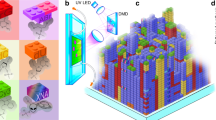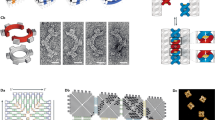Abstract
Readily programmable chemical networks are important tools as the scope of chemistry expands from individual molecules to larger molecular systems. Although many complex systems are constructed using conventional organic and inorganic chemistry, the programmability of biological molecules such as nucleic acids allows for precise, high-throughput and automated design, as well as simple, rapid and robust implementation. Here we show that systematic and quantitative control over the diffusivity and reactivity of DNA molecules yields highly programmable chemical reaction networks (CRNs) that execute at the macroscale. In particular, we designed and implemented non-enzymatic DNA circuits capable of performing pattern-transformation algorithms such as edge detection. We also showed that it is possible to fine-tune and multiplex such circuits. We believe these strategies will provide programmable platforms on which to prototype CRNs, discover bottom-up construction principles and generate patterns in materials.
This is a preview of subscription content, access via your institution
Access options
Subscribe to this journal
Receive 12 print issues and online access
$259.00 per year
only $21.58 per issue
Buy this article
- Purchase on Springer Link
- Instant access to full article PDF
Prices may be subject to local taxes which are calculated during checkout





Similar content being viewed by others
References
Belowich, M. E. & Stoddart, J. F. Dynamic imine chemistry. Chem. Soc. Rev. 41, 2003–2024 (2012).
Rowan, S. J., Cantrill, S. J., Cousins, G. R., Sanders, J. K. & Stoddart, J. F. Dynamic covalent chemistry. Angew. Chem. Int. Ed. 41, 898–952 (2002).
Burda, C., Chen, X., Narayanan, R. & El-Sayed, M. A. Chemistry and properties of nanocrystals of different shapes. Chem. Rev. 105, 1025–1102 (2005).
Rycenga, M. et al. Controlling the synthesis and assembly of silver nanostructures for plasmonic applications. Chem. Rev. 111, 3669–3712 (2011).
Xia, Y., Xiong, Y., Lim, B. & Skrabalak, S. E. Shape-controlled synthesis of metal nanocrystals: simple chemistry meets complex physics? Angew. Chem. Int. Ed. 48, 60–103 (2009).
Epstein, I. R. & Showalter, K. Nonlinear chemical dynamics: oscillations, patterns, and chaos. J. Phys. Chem. 100, 13132–13147 (1996).
Sakurai, T., Mihaliuk, E., Chirila, F. & Showalter, K. Design and control of wave propagation patterns in excitable media. Science 296, 2009–2012 (2002).
Bansagi, T. Jr, Vanag, V. K. & Epstein, I. R. Tomography of reaction–diffusion microemulsions reveals three-dimensional Turing patterns. Science 331, 1309–1312 (2011).
Zaikin, A. N. & Zhabotinsky, A. M. Concentration wave propagation in two-dimensional liquid-phase self-oscillating system. Nature 225, 535–537 (1970).
Adamatzky, A. & De Lacy Costello, B. Experimental logical gates in a reaction–diffusion medium: the XOR gate and beyond. Phys. Rev. E. 66, 046112 (2002).
Vanag, V. K., Yang, L., Dolnik, M., Zhabotinsky, A. M. & Epstein, I. R. Oscillatory cluster patterns in a homogeneous chemical system with global feedback. Nature 406, 389–391 (2000).
Petrov, V., Ouyang, Q. & Swinney, H. L. Resonant pattern formation in a chemical system. Nature 388, 655–657 (1997).
Grzybowski, B. A. Chemistry in Motion: Reaction–Diffusion Systems for Micro- and Nanotechnology (Wiley, 2009).
Adamatzky, A. I. Universal computation in excitable media: the 2+ medium. Adv. Mater. Opt. Electron. 7, 263–272 (1997).
Hjelmfelt, A., Weinberger, E. D. & Ross, J. Chemical implementation of neural networks and Turing machines. Proc. Natl Acad. Sci. USA 88, 10983–10987 (1991).
Pinheiro, A. V., Han, D., Shih, W. M. & Yan, H. Challenges and opportunities for structural DNA nanotechnology. Nature Nanotech. 6, 763–772 (2011).
Ke, Y., Ong, L. L., Shih, W. M. & Yin, P. Three-dimensional structures self-assembled from DNA bricks. Science 338, 1177–1183 (2012).
Wei, B., Dai, M. & Yin, P. Complex shapes self-assembled from single-stranded DNA tiles. Nature 485, 623–626 (2012).
Omabegho, T., Sha, R. & Seeman, N. C. A bipedal DNA Brownian motor with coordinated legs. Science 324, 67–71 (2009).
Lund, K. et al. Molecular robots guided by prescriptive landscapes. Nature 465, 206–210 (2010).
Gu, H., Chao, J., Xiao, S-J. & Seeman, N. C. A proximity-based programmable DNA nanoscale assembly line. Nature 465, 202–205 (2010).
Kim, J. & Winfree, E. Synthetic in vitro transcriptional oscillators. Mol. Syst. Biol. 7, 465 (2011).
Kim, J., White, K. S. & Winfree, E. Construction of an in vitro bistable circuit from synthetic transcriptional switches. Mol. Syst. Biol. 2, 68 (2006).
Padirac, A., Fujii, T. & Rondelez, Y. Bottom-up construction of in vitro switchable memories. Proc. Natl Acad. Sci. USA 109, E3212–3220 (2012).
Fujii, T. & Rondelez, Y. Predator–prey molecular ecosystems. ACS Nano 7, 27–34 (2013).
Seelig, G., Soloveichik, D., Zhang, D. Y. & Winfree, E. Enzyme-free nucleic acid logic circuits. Science 314, 1585–1588 (2006).
Zhang, D. Y., Turberfield, A. J., Yurke, B. & Winfree, E. Engineering entropy-driven reactions and networks catalyzed by DNA. Science 318, 1121–1125 (2007).
Yin, P., Choi, H. M., Calvert, C. R. & Pierce, N. A. Programming biomolecular self-assembly pathways. Nature 451, 318–322 (2008).
Stojanovic, M. N. & Stefanovic, D. A deoxyribozyme-based molecular automaton. Nature Biotech. 21, 1069–1074 (2003).
Soloveichik, D., Seelig, G. & Winfree, E. DNA as a universal substrate for chemical kinetics. Proc. Natl Acad. Sci. USA 107, 5393–5398 (2010).
Qian, L. & Winfree, E. Scaling up digital circuit computation with DNA strand displacement cascades. Science 332, 1196–1201 (2011).
Qian, L., Winfree, E. & Bruck, J. Neural network computation with DNA strand displacement cascades. Nature 475, 368–372 (2011).
Kuhnert, L., Agladze, K. I. & Krinsky, V. I. Image-processing using light-sensitive chemical waves. Nature 337, 244–247 (1989).
Basu, S., Gerchman, Y., Collins, C. H., Arnold, F. H. & Weiss, R. A synthetic multicellular system for programmed pattern formation. Nature 434, 1130–1134 (2005).
Tabor, J. J. et al. A synthetic genetic edge detection program. Cell 137, 1272–1281 (2009).
Li, B., Ellington, A. D. & Chen, X. Rational, modular adaptation of enzyme-free DNA circuits to multiple detection methods. Nucleic Acids Res. 39, e110 (2011).
Chen, X., Briggs, N., McLain, J. R. & Ellington, A. D. Stacking nonenzymatic circuits for high signal gain. Proc. Natl Acad. Sci. USA 110, 5386–5391 (2013).
Wagner, N. & Ashkenasy, G. Systems chemistry: logic gates, arithmetic units, and network motifs in small networks. Chem. Eur. J. 15, 1765–1775 (2009).
Nitschke, J. R. Systems chemistry: molecular networks come of age. Nature 462, 736–738 (2009).
von Kiedrowski, G., Otto, S. & Herdewijn, P. Welcome home, systems chemists! J. Syst. Chem. 1, 1 (2010).
Kondo, S. & Miura, T. Reaction–diffusion model as a framework for understanding biological pattern formation. Science 329, 1616–1620 (2010).
Allen, P. B., Chen, X., Simpson, Z. B. & Ellington, A. D. Modeling scalable pattern generation in DNA reaction network. Proc. Int. Conf. Sim. Synth. Living Syst. 13, 441–448 (2012).
Abelson, H. et al. Amorphous computing. Commun. ACM 43, 74–82 (2000).
Sacca, B. & Niemeyer, C. M. Functionalization of DNA nanostructures with proteins. Chem. Soc. Rev. 40, 5910–5921 (2011).
Zadeh, J. N., Wolfe, B. R. & Pierce, N. A. Nucleic acid sequence design via efficient ensemble defect optimization. J. Comput. Chem. 32, 439–452 (2011).
Acknowledgements
This work was supported by the National Institute of Health (NIH) (R01GM094933) and a National Security Science and Engineering Faculty Fellowship (FA9550-10-1-0169). P.B.A. was supported by an NIH National Research Service Award Fellowship (1 F32 GM095280). X.C. was partially supported by a postdoctoral trainee fellowship from the Cancer Prevention Research Institute of Texas. We thank S. N. Adai for assistance with editing.
Author information
Authors and Affiliations
Contributions
S.M.C. designed sequences for several circuits and performed the majority of the experiments. Z.B.S. and P.B.A. performed computer simulations. A.D.E. supervised the project and designed diffusion-programming tests and some quantitative analyses. X.C. conceived the project, designed most circuits and performed pilot experiments. S.M.C., X.C., P.B.A. and A.D.E. wrote the manuscript.
Corresponding authors
Ethics declarations
Competing interests
The authors declare no competing financial interests.
Supplementary information
Supplementary information
Supplementary information (PDF 1440 kb)
Rights and permissions
About this article
Cite this article
Chirieleison, S., Allen, P., Simpson, Z. et al. Pattern transformation with DNA circuits. Nature Chem 5, 1000–1005 (2013). https://doi.org/10.1038/nchem.1764
Received:
Accepted:
Published:
Issue Date:
DOI: https://doi.org/10.1038/nchem.1764
This article is cited by
-
Signal-processing and adaptive prototissue formation in metabolic DNA protocells
Nature Communications (2022)
-
Spatiotemporal patterning of photoresponsive DNA-based hydrogels to tune local cell responses
Nature Communications (2021)
-
Programming Methods for DNA-Based Reaction–Diffusion Systems
New Generation Computing (2020)
-
Multi-level patterning nucleic acid photolithography
Nature Communications (2019)
-
Signalling and differentiation in emulsion-based multi-compartmentalized in vitro gene circuits
Nature Chemistry (2019)



